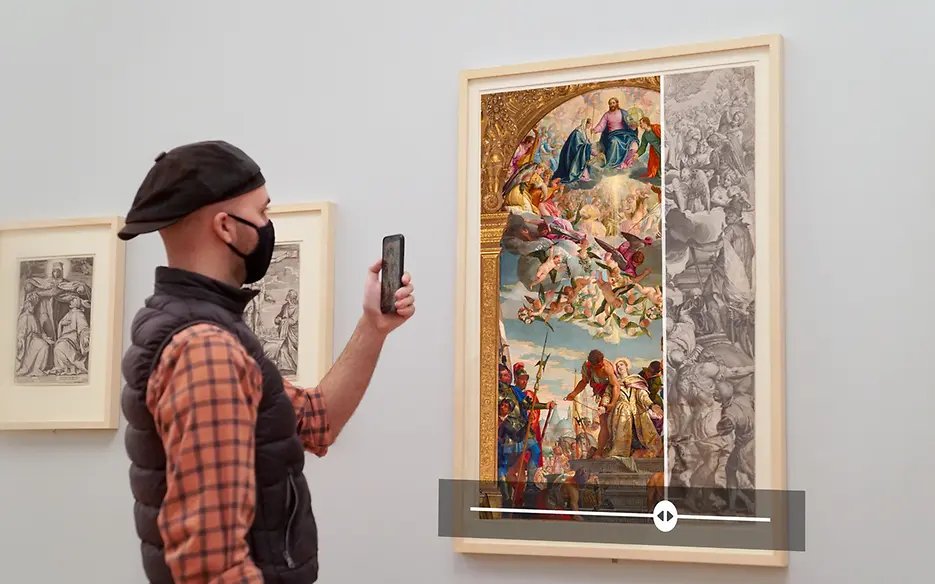
The Future of Art Galleries in the Digital Age
- Art Galleries and Their Role Today
- Digital Vs. Physical: Who Is Winning?
- Digital offers:
- Physical offers:
- Digital Art Ownership in 2024
- Upcoming Challenges and Solutions
- Maintaining Authenticity in a Digital World
- Balancing Physical and Digital Experiences
- Reaching New Audiences and Staying Relevant
- Monetization in the Digital Age
- In Conclusion
The art gallery, a cornerstone of artistic discovery for centuries, finds itself at a crossroads. The digital age, with its disruptive technologies and global reach, is forcing a reevaluation of the traditional gallery model. However, this transformation presents not just challenges, but also exciting opportunities.
So, let’s delve into today’s market and explore how art galleries are adapting to the digital landscape. Here we’ll analyze how their role has changed, who is the king of the hill in the art market, and what anyone interested in art should expect from the future.

Art Galleries and Their Role Today
Once unchallenged gateways between artists and collectors, art galleries have remained a crucial part of the art market but now have to adapt to new, digital age chances. Traditionally, they served as curated spaces, showcasing established artists and acting as gatekeepers to the art world. However, the internet has changed the status quo.
Today, galleries still offer crucial exposure and foster artistic careers, but the focus has broadened. While established artists remain a cornerstone, galleries increasingly explore new avenues to support a broader range of creative voices. For instance, the rise of digital art forms like NFTs offers them exciting possibilities, and galleries are well aware of this new frontier and its importance.
Physical gallery spaces have also undergone a transformative change. Although the physical space remains irreplaceable, virtual platforms have offered unparalleled global reach that nobody wants to lose. That's why galleries now evolve into hybrid entities, leveraging technology to enhance the visitor experience through interactive displays, VR tours of exhibitions, or AR installations that bring art to life. These immersive experiences, coupled with curated shows, artist talks, and educational programs, once again make galleries feel like vibrant cultural hubs.
In the modern art market, galleries are no longer solely brick-and-mortar spaces. They are dynamic platforms embracing technology to expand their reach, support a diverse range of artistic expressions, and shape a more inclusive future for art appreciation.
Digital Vs. Physical: Who Is Winning?
Although we feel the impact of the art world's digital evolution, there's still no clear winner. Consider it more like a potent tag team! Each side has much to offer, making it valued in the art industry. For instance,
Digital offers:
- Global Access to exhibitions and collections for anyone with an internet connection, which democratizes art.
- Lower Costs to curate and sell digital art, making it more affordable for collectors.
- New Formats like VR tours and AR displays that create immersive and engaging ways to experience art.

Physical offers:
- Tactile sensations of art's scale, texture, and subtle details.
- Curated Encounters with a specific flow, context, and a unique viewing experience.
- Community Hubs for social interaction, artist talks, and events that foster a sense of community around art.
The future of art appreciation lies in blending both worlds. This way, galleries not only expand the reach of art but also deepen engagement, offering a more comprehensive and enriching art experience. It's a future that strengthens the art industry as a whole.
Digital Art Ownership in 2024
Although the era of loud headlines has passed, blockchain technology still makes owning digital art more secure and exciting than just right-clicking and saving an image.
NFTs (Non-Fungible Tokens) function as deeds for digital art. They reside on a secure online ledger known as a blockchain and, when purchased, provide a unique token that verifies ownership and serves as a record of authenticity. This system not only empowers artists to monetize their digital creations but also assures collectors of the security and transparency of their investments. As a result, everyone feels more confident and reassured in their digital collections.

Nonetheless, the world of digital art ownership in 2024 has its complexities. Understanding and adopting NFTs can be a barrier for galleries and their audiences. However, their security, transparency, and the new avenues for artistic expression are worth the effort.
Upcoming Challenges and Solutions
While virtual galleries and online exhibitions offer exciting new avenues for discovery and accessibility, they also present novel challenges. Dealing with them is crucial to pave the way for a thriving future, and the industry has already started looking for and adopting solutions for some of them.
Maintaining Authenticity in a Digital World
With readily available digital copies, ensuring the authenticity and provenance of artworks, particularly digital ones, is a complex task.
- Embrace NFTs: Utilizing NFTs as certificates of authenticity for digital art provides a secure record of ownership and transaction history.
- Digital Watermarking: Embedding semi-visible logos or invisible codes in digital artworks can help track ownership and deter unauthorized duplication.
Balancing Physical and Digital Experiences
Galleries struggle to find the right balance between the irreplaceable experience of physical galleries and the global reach of virtual spaces.
- Hybrid Experiences: Integrate AR and VR technology into physical galleries to create an even more interactive physical experience.
- Curated Online Exhibitions: Develop a high-quality online platform with virtual avatars to create a more immersive digital experience.
Reaching New Audiences and Staying Relevant
With a growing influx of online content, capturing audience attention and staying relevant in a saturated digital space can be difficult.
- Embrace Social Media: Utilize social media platforms to showcase artwork, engage with audiences, and promote events.
- Focus on Community Building: Host online artist talks, workshops, and discussions to foster a sense of community around the gallery and the artists it represents.
Explore New Technologies: Stay on top of technologies like NFT, AR, and VR to create innovative engagement models.

Monetization in the Digital Age
Creating sustainable revenue streams in the digital art world, where virtual copies are readily available, requires time, resources, skills, and dedication.
- Digital Sales Platforms: Develop online platforms to sell digital artworks directly to collectors. Some companies have already established marketplaces with robust and simple management interfaces.
- Subscription Models: Offer subscription services granting access to exclusive content, artist talks, or virtual events using your own platform or services like Patreon.
- Embrace New Art Forms: Consider representing artists who create NFTs or explore new forms of digital art with the potential for unique ownership experiences.
In Conclusion
Thanks to the digital evolution, the future of art galleries has exciting possibilities.
While the internet may have initially seemed like a threat, it's actually morphing galleries into dynamic centers for artistic exploration. Virtual spaces dissolve geographical barriers, and cutting-edge technologies create immersive experiences. Additionally, the rise of NFTs is empowering artists with new avenues for creative expression and secure ownership models.
Sure, challenges exist, but by embracing technology and fostering a synergy between the two worlds, art galleries are poised to become even more vibrant hubs.
Related articles





